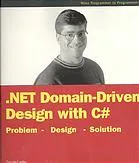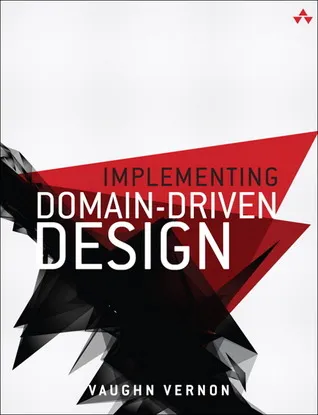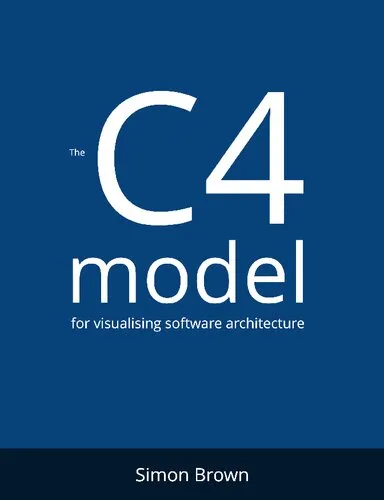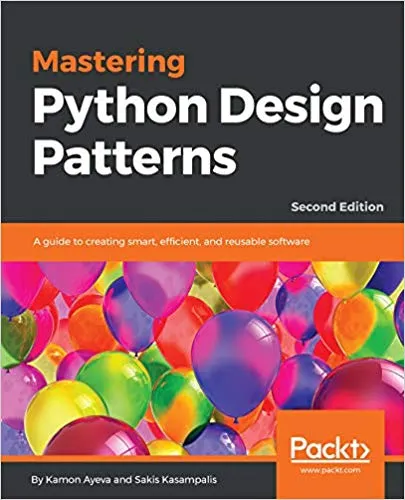Learning Domain-Driven Design: Aligning Software Architecture and Business Strategy
4.5
بر اساس نظر کاربران

شما میتونید سوالاتتون در باره کتاب رو از هوش مصنوعیش بعد از ورود بپرسید
هر دانلود یا پرسش از هوش مصنوعی 2 امتیاز لازم دارد، برای بدست آوردن امتیاز رایگان، به صفحه ی راهنمای امتیازات سر بزنید و یک سری کار ارزشمند انجام بدینکتاب های مرتبط:
Persian Summary
معرفی کتاب 'Learning Domain-Driven Design: Aligning Software Architecture and Business Strategy'
کتاب 'Learning Domain-Driven Design: Aligning Software Architecture and Business Strategy' نوشته ولاد خانونوف، راهنمایی جامع برای تسلط بر مفهوم Domain-Driven Design یا به اختصار DDD است. این کتاب به خوانندگان کمک میکند تا طراحی نرمافزار خود را با استراتژیهای کسب و کار هماهنگ کنند و از رویکردهای پیچیده طراحی موثر بهرهمند شوند.
خلاصه تفصیلی کتاب
این کتاب با هدف فراهم کردن یک درک عمیق و جامع از اصول و تکنیکهای Domain-Driven Design نوشته شده است. نویسنده با دقتی خاص، مفاهیمی مانند Bounded Context، Ubiquitous Language و Event Storming را توضیح میدهد و کاربرد عملی آنها را در حل مشکلات تجاری پیچیده نشان میدهد. با ارائه مثالهای عملی و موارد کاوری از دنیای واقعی، این کتاب به خوانندگان کمک میکند تا بهتر ارتباط بین طراحی نرمافزار و اهداف کسبوکاری را درک کنند.
یکی از اهداف اصلی این کتاب، آموزش چگونگی ایجاد یک زبان مشترک یا همان Ubiquitous Language است که توسعهدهندگان نرمافزار و ذینفعان تجاری بتوانند برای بهبود ارتباطات از آن استفاده کنند. این ارتباط بهتر منجر به شفافیت بیشتر در پروژهها و کاهش خطرات معمول در توسعه نرمافزاری میشود.
نکات کلیدی از کتاب
- شناخت صحیح و تفکیک مفاهیم کلیدی Domain-Driven Design از قبیل Bounded Context و Ubiquitous Language.
- فهم چگونگی ارتباط بین طراحی نرمافزار و استراتژیهای کسب و کار.
- بهکارگیری تکنیکهای Event Storming برای شناسایی و مدلسازی متدولوژیها.
- بهبود همکاری بین تیمهای فنی و تجاری از طریق پرورش یک زبان مشترک.
نقلقولهای مشهور از کتاب
"DDD isn't about technology or processes; it's about understanding your domain."
"The true value of DDD emerges when the boundaries of software align with business boundaries."
چرا این کتاب مهم است؟
در دنیای امروزی که کسب و کارها با پیچیدگیهای زیادی مواجه هستند، توانایی درک و هماهنگسازی نرمافزار با اهداف سازمانی از اهمیت ویژهای برخوردار است. این کتاب ابزاری قدرتمند برای تیمهای توسعه نرمافزار فراهم میکند تا از طریق روشهای مدرن طراحی، ارزش بیشتری برای کسب و کارهای خود ایجاد کنند. از طریق یادگیری و استفاده از Domain-Driven Design، قادر خواهید بود تا نرمافزارهایی ایجاد کنید که نه تنها به خوبی کار میکنند، بلکه به استراتژیهای کلان کسب و کار نیز هماهنگ هستند.
Introduction to 'Learning Domain-Driven Design: Aligning Software Architecture and Business Strategy'
In the intricate landscape of software development, aligning technology with business objectives is a challenging yet imperative task. "Learning Domain-Driven Design: Aligning Software Architecture and Business Strategy" is a comprehensive guide aimed at bridging the gap between these often disparate worlds. Authored by Vlad Khononov, this book serves as a gateway to understanding the principles of Domain-Driven Design (DDD) and how they can be effectively applied to create synergy between an organization’s technical capabilities and its strategic goals.
Whether you're a seasoned architect, an up-and-coming developer, or a business stakeholder willing to dive into technical realms, this book provides an insightful journey through the foundational concepts, intricate patterns, and strategic decisions necessary for impactful software design. It emphasizes the importance of continuous collaboration and communication between software developers and domain experts to create systems that not only function efficiently but also drive business success.
Detailed Summary of the Book
The book starts by setting the stage with an exploration of the core principles behind Domain-Driven Design (DDD). It defines what domains are and why understanding them is vital to any software development endeavor. With clarity, the author dissects the basic building blocks of DDD, including entities, value objects, aggregates, services, repositories, and factories, providing readers with a fundamental understanding of how these elements interconnect within a cohesive design.
The narrative then progresses into strategic design patterns, guiding readers through the practical application of DDD in complex systems. By emphasizing concepts such as bounded contexts and ubiquitous language, the book illustrates how to delineate distinct parts of a system while ensuring that communication between these segments is clear and effective.
Moreover, the book delves into how DDD can be employed as a tool for fostering better collaboration across multidisciplinary teams, including developers, analysts, and business experts. It underscores the importance of aligning technical decisions with business priorities through continuous feedback loops and iterative refinement processes.
Key Takeaways
- Understanding the importance of domain knowledge in driving technical solutions.
- Fundamental concepts of Domain-Driven Design and their practical application.
- The role of ubiquitous language in fostering clearer communication and collaboration.
- Real-world strategies for implementing bounded contexts and managing domain-driven projects.
- Techniques for aligning software design with business strategy effectively.
Famous Quotes from the Book
"Domain-Driven Design is not just a methodology; it's a journey towards bridging the gap between business insight and technical excellence."
"The power of a model resides not in the accretion of details, but in their reduction."
Why This Book Matters
"Learning Domain-Driven Design: Aligning Software Architecture and Business Strategy" stands out as an essential resource for anyone involved in software development. The book’s significance lies in its holistic approach to tackling the complex challenges of aligning software architecture with business strategies. It doesn't just offer technical guidance but also provides a strategic perspective, which is crucial for any organization's success in today's competitive environment.
By equipping readers with the knowledge and tools to implement DDD effectively, the book ensures that their software projects not only meet technical specifications but also contribute to achieving broader business objectives. This alignment is critical for ensuring that software solutions remain relevant, scalable, and capable of delivering tangible business value, making this book a vital read for professionals across the development and business spectrum.
دانلود رایگان مستقیم
شما میتونید سوالاتتون در باره کتاب رو از هوش مصنوعیش بعد از ورود بپرسید
دسترسی به کتابها از طریق پلتفرمهای قانونی و کتابخانههای عمومی نه تنها از حقوق نویسندگان و ناشران حمایت میکند، بلکه به پایداری فرهنگ کتابخوانی نیز کمک میرساند. پیش از دانلود، لحظهای به بررسی این گزینهها فکر کنید.
این کتاب رو در پلتفرم های دیگه ببینید
WorldCat به شما کمک میکنه تا کتاب ها رو در کتابخانه های سراسر دنیا پیدا کنید
امتیازها، نظرات تخصصی و صحبت ها درباره کتاب را در Goodreads ببینید
کتابهای کمیاب یا دست دوم را در AbeBooks پیدا کنید و بخرید
سوالات پرسیده شده از این کتاب
1986
بازدید4.5
امتیاز50
نظر98%
رضایتنظرات:
4.5
بر اساس 0 نظر کاربران
"کیفیت چاپ عالی بود، خیلی راضیام"
Questions & Answers
Ask questions about this book or help others by answering
No questions yet. Be the first to ask!


















